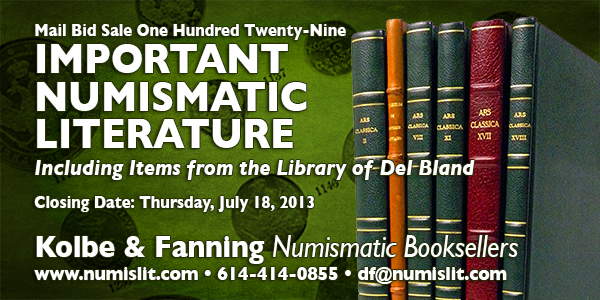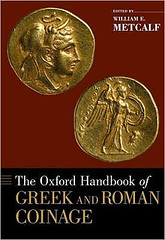
PREV ARTICLE
NEXT ARTICLE
FULL ISSUE
PREV FULL ISSUE
BOOK REVIEW: OXFORD HANDBOOK OF GREEK AND ROMAN COINAGE
A nice review of The Oxford Handbook of Greek and Roman Coinage by
Roger Kuntz was published in the July-August 2013 issue of RNA News, the newsletter of the Rochester Numismatic Association. We're republishing it here for readers of The E-Sylum with the kind permission of the author and RNA Associate Editor Ted Vaccarella. Thanks! I added a link to the publisher's web site. The list price is $150, although the book is available at various lower prices in other venues such as Amazon.com and Barnes & Noble (bn.com).
-Editor
This book represents an unprecedented innovation in numismatic literature and is becoming widely regarded as the best introduction to classical ancient coins. It is far more than a guide written solely for collectors. Instead, it was written to serve also as an introduction for graduate or post-doctoral students in the ancient cultures who seek training in classical numismatics. As a work in the renowned Oxford Handbooks series, this volume was written to offer an authoritative and annotated state-of-the-art survey of current thinking and research in the subject area. However, it is just that focus that makes it such a valuable text for serious collectors of ancient coins. The book contains a collection of 33 essays, covering all aspects of Greek and Roman numismatics. Each chapter has been contributed by the authority having pre-eminent expertise in the topic under consideration. The presumption by all 33 of the contributors has been that readers would have no previous knowledge of any aspect of numismatics, thus keeping this volume accessible to readers at all levels. It begins with a general introduction by the editor, William E. Metcalf. His article considers the role of scientific analysis in our discipline, explaining how numismatic research is done in the 21st-century. After that introduction, the following 32 chapters, each written in an easy prose-style, constitute an account of the history and evolution of ancient coinage. Each essay provides a systematic overview of the topic as well as a critical account of the progress of numismatic study, illustrating throughout the book how modern techniques such as die studies, hoard analysis, and mint-output data have advanced our knowledge of ancient numismatics. This survey rightly begins with the electrum coins of Lydia. This innovation was followed some 80 years later by the introduction of a bi-metallic (silver and gold) monetary system. A prolific silver coinage was introduced at Athens with-in a generation, and it soon inundated the economies of the Aegean and the Near East. The type, featuring Athena and her owl, was struck over four centuries, becoming the first coinage accepted throughout the known world. This was followed by a bewildering array of types struck to a plethora of standards that are well-described here. The typological diversity of these and the Roman Republican issues is well-illustrated. During Caesar’s monarchy, he was allowed the privilege of placing his portrait on his coins, thus resulting in the development of portraiture as the most powerful instrument of numismatic propaganda – an iconographic development that has persisted until modern times. The evolution of imperial titles under succeeding emperors is examined in detail. The development of reverse types in great variety stressed imperial achievements and the current events of their day. The interplay between metropolitan and provincial issues is ably illustrated. By the beginning of the 3rd-century, monetary pluralism prevailed. While Roman coinage may appear to the casual observer to adhere over time to tradition, it was actually in a constant state of change. Each short-lived dynasty made significant alterations according to its own familial needs. The use of female portraits as obverse types is explained in terms of dynastic propaganda. The reasons for the issuance of commemorative coins and the types proclaiming religious beliefs are discussed. Finally, the appearance of idiosyncratic types and unusual minting practices that made the later Roman coins so complicated is explained. The overall impression is one of stability during the first century followed by gradual decline in the later centuries. The currency system established by Augustus collapsed during the third century and was replaced by a “Late-Roman” system based on the use of smaller base metal coins. The iconographic tradition of realistic portraiture inherited from the Greeks gave way to the use of idealized portraits in the decades before the introduction of Byzantine types. William E. Metcalf is a former curator at the American Numismatic Society and currently serves as an Adjunct Professor of Classics at Yale University and the Ben Lee Damsky Curator of Coins and Medals at the Yale Art Gallery. This volume contains 900 digital photographs of ancient coins that have been placed at the appropriate points within each essay. Each chapter is also accompanied by its own very extensive bibliography. This book is now being acclaimed as the most informative single-volume work on ancient coinage that has been published to date. As such, it belongs in the library of every collector who has a broad interest in all facets of numismatics. For more information, or to order, see: The Oxford Handbook of Greek and Roman Coinage (global.oup.com/academic/product/the-oxford-handbook-of-greek-and-roman-coinage-9780195305746?cc=us&lang=en&) For more information about the Rochester Numismatic Association, see: www.the-rna.com

Wayne Homren, Editor The Numismatic Bibliomania Society is a non-profit organization promoting numismatic literature. See our web site at coinbooks.org. To submit items for publication in The E-Sylum, write to the Editor at this address: whomren@gmail.com To subscribe go to: https://my.binhost.com/lists/listinfo/esylum All Rights Reserved. NBS Home Page Contact the NBS webmaster 
|
